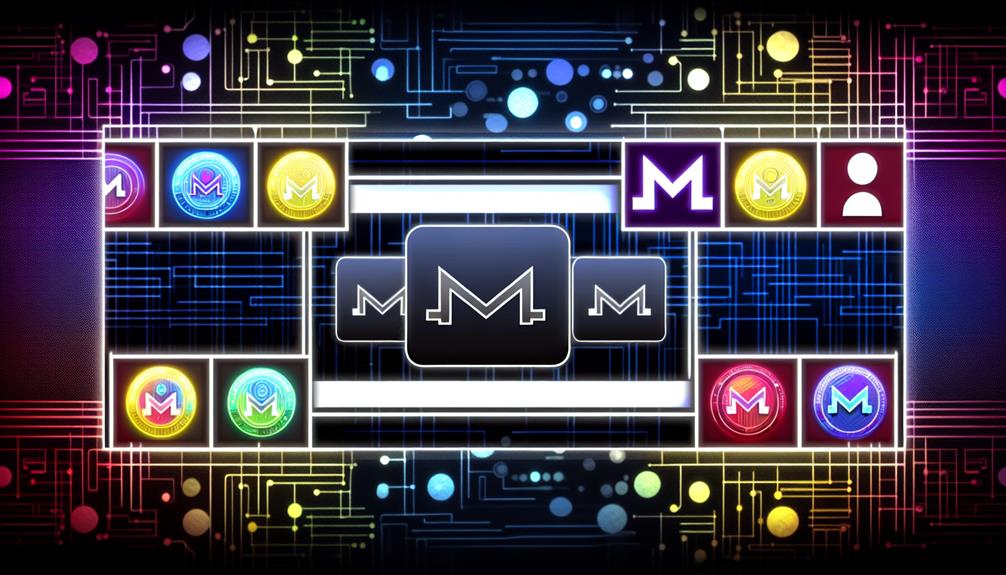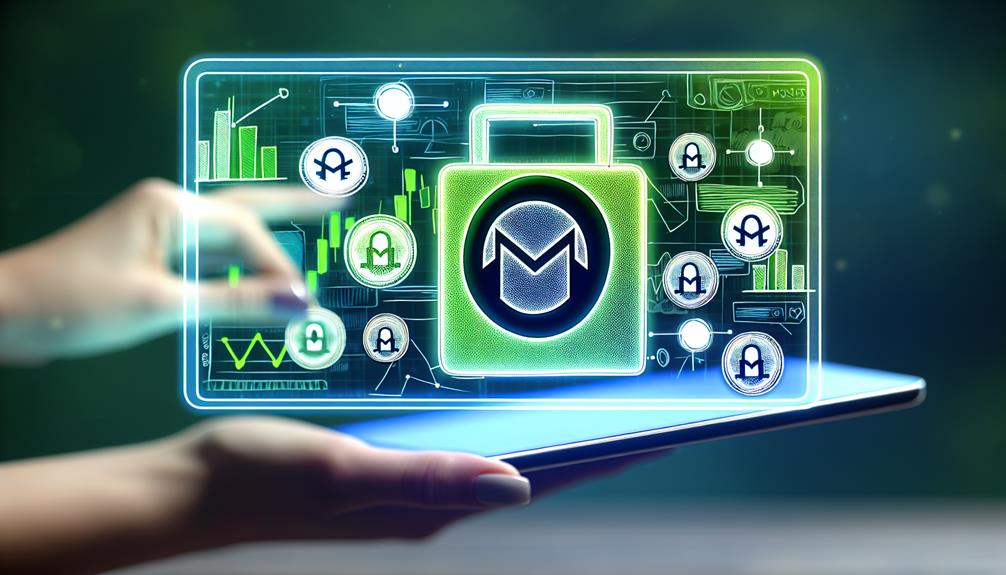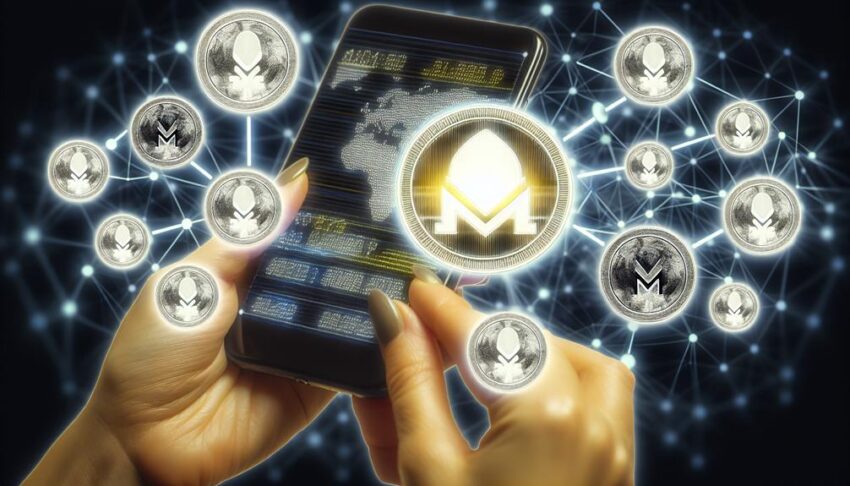When you're looking to add money to your Monero wallet, it's important to grasp the steps involved to guarantee a smooth and secure transaction. You'll start by purchasing Monero (XMR) from a reputable exchange, but there are several nuances to take into account, including account security and wallet management. Once you've acquired XMR, transferring it to your personal wallet requires attention to detail. If you're unsure about the best practices or alternative methods for acquiring XMR, there are a few options that might surprise you. Let's explore those further.
Understanding Monero Wallets

Understanding Monero wallets involves grasping the fundamental principles of privacy and security that underpin this cryptocurrency. Monero differs from many other digital currencies by emphasizing transaction privacy, ensuring that your financial activities remain confidential. To effectively manage your Monero assets, you need to familiarize yourself with the various wallet types available.
There are several wallet types you might consider: hardware wallets, software wallets, and web wallets. Hardware wallets are physical devices that store your private keys offline, providing enhanced security against hacking attempts. Software wallets, which can be desktop or mobile applications, offer convenience but require stricter security measures to protect against malware. Web wallets, while user-friendly, expose you to potential risks as your private keys are managed online.
Each wallet type has its own implications for transaction privacy. Hardware wallets generally offer the highest level of security, making them suitable for long-term storage. Software wallets, while more accessible for everyday transactions, can present vulnerabilities if not properly secured. Web wallets are the least secure option, as they depend on third-party services, which may not prioritize your privacy.
When selecting a wallet, consider how much privacy you need. Monero's design makes it inherently private, but the wallet you choose can influence how well you maintain that privacy during transactions. Understanding these nuances will help you make informed decisions as you manage your Monero holdings securely and privately.
Setting Up Your Monero Wallet
How do you go about setting up your Monero wallet? The first step is to choose the right wallet type that fits your needs. There are several wallet types available: desktop, mobile, hardware, and paper wallets. Each has its advantages, such as ease of use and security. For beginners, a desktop or mobile wallet is typically the most accessible option, while hardware wallets offer enhanced security for those holding larger amounts.
Once you've selected your wallet type, you can begin the setup process. If you opt for a software wallet, download the official Monero GUI or a trusted third-party wallet app. After installation, launch the application and follow the prompts to create a new wallet. You'll need to generate a strong password and make sure to securely store your recovery seed phrase. This phrase is essential; losing it means losing access to your funds.
For hardware wallets, connect the device to your computer and follow the manufacturer's instructions to initialize the wallet. Make sure to update the firmware to the latest version for peak security.
If you decide to use a paper wallet, visit a reputable paper wallet generator, ensuring you're offline to prevent exposure to potential malware. Carefully generate and print your wallet, and store it in a secure location.
Purchasing Monero From Exchanges

With your Monero wallet set up, you're ready to acquire some XMR. The first step is to choose a reliable Monero exchange. Popular options include Binance, Kraken, and Huobi, known for their security and liquidity. Each exchange has its own set of trading strategies and fee structures, so it's crucial to research which platform aligns best with your needs.
Once you've selected an exchange, you'll need to create an account. This typically involves providing your email address and setting up two-factor authentication for added security. After verification, you can deposit funds into your exchange account. Most exchanges accept deposits in fiat currencies like USD or EUR, as well as cryptocurrencies. Make sure you understand the deposit methods available, as some may take longer than others.
When you're ready to purchase Monero, navigate to the trading section of the exchange. You'll see various trading pairs, such as XMR/USD or XMR/BTC. Depending on your trading strategy, you can place market orders for immediate purchases or limit orders to buy at a specific price.
After executing the trade, your purchased XMR will be credited to your exchange wallet. It's advisable to keep your Monero in a secure wallet rather than on the exchange. This adds an extra layer of security, protecting your investment from potential hacks or exchange failures. Now, you're one step closer to managing your Monero assets effectively.
Transferring Funds to Your Wallet
To transfer funds to your Monero wallet, you'll first need to acquire your wallet address. This address is essential for ensuring that your Monero coins reach the correct destination. Next, you can choose from various transfer methods to complete the transaction efficiently.
Wallet Address Acquisition
Acquiring your Monero wallet address is an essential step for transferring funds securely. Depending on the wallet type you're using—whether it's a software wallet, hardware wallet, or a mobile wallet—you'll need to access the specific address format associated with your wallet. Monero addresses typically fall into three categories: standard addresses, subaddresses, and integrated addresses.
To get your address, simply open your Monero wallet application. You'll find your wallet address displayed prominently on the home screen or under the "Receive" tab. For standard addresses, it usually begins with a "4" and consists of 95 characters. If you're using subaddresses, these are designed to enhance privacy and allow you to generate multiple addresses from a single wallet. Integrated addresses, which combine your wallet address with a payment ID, are particularly useful for transactions but can vary in length.
Once you've identified the correct address format, copy the address carefully, ensuring no characters are omitted or altered. This address is what you'll provide to anyone sending you Monero, guaranteeing that your funds are transferred directly to your wallet.
Transfer Methods Overview
After you've obtained your Monero wallet address, it's time to explore the various methods for transferring funds into your wallet. There are several options available, each with its own characteristics regarding transfer fees and transaction speed.
The most common method is purchasing Monero from a cryptocurrency exchange. You can deposit fiat currency, buy Monero, and then withdraw it directly to your wallet. This method typically involves transfer fees and may have varying transaction speeds based on the exchange's processing times.
Another option is peer-to-peer transactions. If you know someone who wants to sell Monero, you can arrange a direct transfer. This method may reduce transfer fees but requires a trusted relationship to guarantee security.
You can also use ATMs that support Monero. These machines allow you to buy Monero using cash or debit cards. However, they often impose higher transfer fees and can vary in transaction speed.
Lastly, consider using online services or platforms that facilitate Monero transactions. These can offer competitive rates but be sure to check their reputation and fees before proceeding. Evaluating these methods will help you choose the best approach for funding your wallet.
Using Peer-to-Peer Transactions

Utilizing peer-to-peer transactions is an effective way to add money to your Monero wallet, enabling direct exchanges without intermediaries. This method allows you to interact directly with other users, which can often lead to lower transaction fees compared to traditional exchanges. Peer-to-peer exchanges not only offer a convenient means of acquiring Monero but also provide greater privacy, aligning with the core principles of the cryptocurrency.
When engaging in peer-to-peer transactions, consider these key points:
- Choose Reputable Platforms: Use established peer-to-peer platforms to minimize risks.
- Verify User Profiles: Always check the reputation and feedback of the user you're trading with.
- Negotiate Terms: Don't hesitate to discuss the transaction terms, including price and payment method.
- Be Aware of Fees: Understand any transaction fees that might apply, even in peer-to-peer settings.
- Use Escrow Services: Whenever possible, utilize escrow services to protect both parties during the transaction.
Best Practices for Security
To secure your Monero wallet, it's essential to use strong passwords that are difficult to guess. Enabling two-factor authentication adds an extra layer of protection, while keeping your software updated guarantees you're protected against vulnerabilities. Implementing these practices will greatly enhance your wallet's security.
Use Strong Passwords
Using strong passwords is critical for securing your Monero wallet against unauthorized access. Weak passwords can be easily compromised, putting your funds at risk. To enhance your security, consider the following best practices:
- Use at least 12 characters, including uppercase and lowercase letters, numbers, and symbols.
- Avoid common phrases or easily guessable information, like birthdays or names.
- Regularly update your password to stay ahead of potential threats.
- Consider using password managers to generate and store complex passwords securely.
- Implement encryption techniques to protect your wallet data further.
Enable Two-Factor Authentication
Enabling two-factor authentication (2FA) adds an important layer of security to your Monero wallet by requiring a second form of verification beyond just your password. This extra step considerably enhances your wallet's security, mitigating risks associated with password theft or unauthorized access. The two factor benefits are clear: even if someone manages to obtain your password, they won't be able to access your wallet without the second verification method.
To set up 2FA, you'll typically need a mobile authenticator app, such as Google Authenticator or Authy. After downloading the app, follow the wallet's instructions to link it to your account. Once enabled, each time you log in or perform a sensitive action, you'll need to provide a time-sensitive code generated by the app.
It's vital to keep your device secure, as losing access could lock you out of your wallet. Always back up your authentication tokens and be cautious of phishing attempts. By enabling authentication, you're taking a proactive step towards safeguarding your Monero assets, ensuring that only you can access them, even in the event of a compromised password.
Keep Software Updated
After securing your Monero wallet with two-factor authentication, the next step in maintaining your wallet's integrity is keeping your software updated. Regular updates are critical for wallet maintenance, as they not only patch security vulnerabilities but also guarantee software compatibility with the Monero network.
Here's what you need to evaluate for effective software updates:
- Check for Updates Regularly: Make it a habit to check for updates weekly to stay ahead of potential threats.
- Use Official Sources: Always download updates from the official Monero website or trusted platforms to avoid malware.
- Backup Your Wallet: Before updating, back up your wallet to prevent data loss in case of any issues.
- Review Release Notes: Understand what changes are included in the update; this can inform you about new features or security fixes.
- Test Updates on a Separate Device: If possible, test updates on a non-primary device to guarantee stability before applying them to your main wallet.
Frequently Asked Questions
Can I Add Funds to Monero Wallet Using Credit Cards?
You can't directly use credit cards for Monero. However, you can utilize credit card exchanges or payment processors that convert your funds into Monero, allowing you to add money indirectly through these platforms.
What Is the Minimum Amount to Send to My Monero Wallet?
When diving into the depths of your Monero wallet, you'll find that the minimum transfer amount typically hovers around 0.0001 XMR, though you should always check wallet transaction limits for specific requirements.
Are There Fees for Adding Money to My Monero Wallet?
Yes, there are transaction costs associated with adding money to your Monero wallet. These fees vary depending on the deposit methods you choose, influencing the overall amount you'll need to send for a successful transaction.
How Long Does It Take to See Funds in My Monero Wallet?
When you initiate a transaction, picture a ripple in water. It typically takes a few minutes to see funds in your Monero wallet, depending on transaction confirmation and wallet synchronization speed. Patience is key.
Is There a Limit on How Much Monero I Can Hold?
There isn't a specific limit on how much Monero you can hold. However, regulations might influence wallet security practices, so make certain your storage methods comply with legal standards to protect your assets effectively.
Conclusion
In summary, enhancing your Monero wallet with funds is a straightforward journey. By embracing exchanges or exploring peer-to-peer avenues, you can discreetly navigate the world of cryptocurrency. Always verify your transactions are secure, and remember that the beauty of Monero lies in its privacy. So, whether you're investing or simply experimenting, you're now equipped to gracefully add funds to your wallet while keeping your financial footprints light and unobtrusive. Happy transacting!
